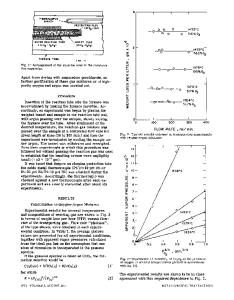Thermodynamics of the system NaF-AIF 3 : Part VI. revision
- PDF / 897,659 Bytes
- 10 Pages / 603.28 x 783.28 pts Page_size
- 88 Downloads / 436 Views
I.
INTRODUCTION
IT
is now some 12 years since the last paper in this series oj was written, and 18 since the section on activities in liquid mixtures appeared, t2J Much important work has been published in the interim, and it is opportune to review the whole situation, even though a similar review has recently been made by Sterten and M~eland.[3] There is a tangle of experimental data, and little of it yields activities of NaF or A1F3 directly; different authors will tend to weigh the evidence differently, and it is only by two (or more) independent reviews that one can begin to discern the factors on which there is agreement and those which are still uncertain. Although the major practical interest in the NaF-A1F3 system lies in the liquids, much of the critical discussion which follows centers on the properties of solid cryolite, nominally Na3A1F6. There are two problems: in the first place, it is nonstoichiometric; t~] in the second, there is doubt about its high-temperature enthalpy content, and hence its entropy. Consequently, one cannot just accept t h e J A N A F [41 tabulation, even though it was revised (1980) in the light of most of the data to be discussed here. There is also a potential problem with the liquids: they have very anomalous enthalpy capacities, t5'6"71to the extent that the usual approximation that ACp's are zero, and hence that A/~'s are independent of temperature, can be grossly untrue. This can make calculations either more complex or less secure than they otherwise would be. In this paper pressures are in bars, energies are in joules, temperatures are in kelvins, and the reference temperature of 298.15 K is often abbreviated to 298 K. The data for liquid mixtures are reduced to 1293 K, where a lot of the measurements were made. To minimize writing subscripts in mathematical expressions, x is sometimes used for NAIF3 , the molar fraction. II.
E N T H A L P I E S OF M I X I N G
Perhaps the most accurately determined quantities in this system are the calorimetric enthalpies of mixing of
ERNEST W. DEWING is a Principal Scientist with the Kingston Laboratory of Alcan International Ltd., P.O. Box 8400, Kingston, ON K7L 5L9, Canada. Manuscript submitted May 11, 1989. METALLURGICAL TRANSACTIONS B
liquid NaF with solid A1F3, [81 of liquid NaF with liquid Na3A1F6, tsj and of liquid Na3A1F6 with solid A1F3, t91 at temperatures from 1284 K to 1298 K - - c l o s e enough to 1293 K that no correction is needed. The data are more than sufficient to determine the enthalpies of mixing in general and the enthalpy of formation of liquid Na3A1F 6 (from NaF (1) and A1F3 (s)) in particular. They have a l l been fitted to AH M = ax + bx 2 + cx 4 + dx s
[1]
where a = - 7 4 140, b = 23 502, c = 2.294 • 106, and d = - 3 . 1 3 9 X 106, with a standard deviation of - 1 8 0 J mol -~. For the values based on mixing cryolite, it is necessary to add - 1 1 255 ( - 59) J for each (0.75 NaF, 0.25 A1F3) in the mixture. This constant is thus the enthalpy of formation of (0.75 NaF, 0.25 A1F3) needed to pull the two t
Data Loading...











